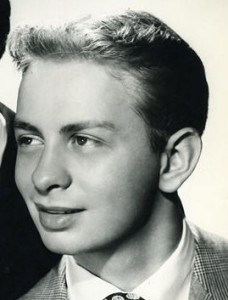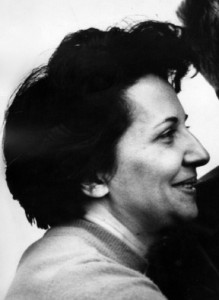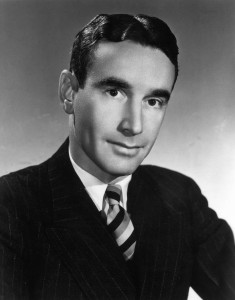Christmas Classics PERSON OF THE DAY: Mel Tormé
On this day in 1925, Melvin Howard Torma, better known as Mel Tormé, was born in Chicago to a Russian Jewish family. He was an accomplished and well-liked jazz composer, scat singer, author, and actor for television and movies. In Christmas music circles he is best known as co-author, along with Robert Wells, of The Christmas Song (a.k.a. Chestnuts Roasting on an Open Fire).
During the World War II years Tormé moved to California, enlisted in the Army, and started his own quintet Mel Tormé & the Mel-Tones. B y 1947 he decided to strike out on his own and then went on to develop a reputation as a cool jazz singer. He did not disappoint in 1948 with Careless Arms, a number one hit. In all “The Velvet Fog” a sobriquet Tormé detested, is credited with 250 songs and the arranger for a host of songs he sang for several recording companies, including Decca and Capitol Records. For a time in the 1960s he was the principal song writer and music arranger for The Judy Garland Show and by the 1970s with the resurgence of jazz singing his career was revitalized and from that time forward he remained a presence in the jazz world until his death.
How Tormé became associated with one of the most popular Christmas songs for the past seven decades is one for the books. During a terrific heat wave besieging Los Angeles in July of 1945, the songwriter Robert Wells sat at his piano and tried to find solace from the heat by jotting down several lines of lyrics with wintry themes. “It was so damn hot, I thought I’d write something to cool myself off,” he once said. “All I could think of was Christmas and cold weather.” While in this mood, his good friend Mel Tormé paid a visit. When Tormé noticed the notes Wells had put to paper, he suggested to him that they just might have the beginnings of a Christmas song.
Within twenty or forty-five minutes, depending upon who’s telling the story, the two songsters produced The Christmas Song. Tormé then went to the home of Nat King Cole and convinced him to record the song, and in the Spring of 1946 Nat went into a New York recording studio with a simple piano version of the song. The initial results weren’t satisfactory, and at the urging of his wife Maria and manager, the mellifluous singer responded with a more highly regarded version with strings and full orchestra. It was Cole’s exquisite recording that popularized the song, and over the years The Christmas Song has consistently ranked as one of America’s seasonal favorites.
Considered an historic recording, the song was honored in 1999, as was Tormé himself for life time achievement, by being inducted by the Grammy Awards organization into its Hall of Fame.
The Christmas Song has truly stood the test of time. This is quite understandable because it was written during an age when composers like Tormé produced music marked by grace and charm. In retrospect it is easily understood why his passing was mourned by many, especially by those nostalgic for such memorable musings from “Chestnuts roasting on an open fire” . . . to . . . “And so I’m offering this simple phrase, To kids from one to ninety-two; Although it’s been said many times, many ways, “Merry Christmas to you.”
Christmas Classics PERSON OF THE DAY: Gloria Shayne
On this day ninety years ago, Gloria Adele Shain was born of a Jewish family in Brookline, Massachusetts. She changed her name to Gloria Shayne early in her professional career as a pianist and composer. In the 1940s she moved to New York,and it was there where she made her mark.
In the world of Christmas music she is famed for composing Do You Hear What I Hear? in collaboration with her husband Noel Regney, a Frenchman.
The Shayne and Regney union was a story of romance. They met in the early 1950’s when the Frenchman came to the Beverly Hotel in New York, now known as the Benjamin Hotel, where Shayne was playing the piano. Both were duly smitten on their chance meeting and a month later the two lovers were married.
Do You Hear What I Hear?, although often taken for a Christmas carol, was actually composed by the husband and wife team as a hymn of peace, one borne out of a sense of desperation and fear of war because of the looming Cuban Missile Crisis. Both composers had not forgotten about the horrors of war. During the World War II years Shayne worked for the Jewish Welfare organization at a time when millions of Jews were being slaughtered by the Nazis. Regney, trained as a classical composer, witnessed its terror first hand when he was conscripted by the German Army, even though he was a Frenchman, but soon deserted it to join the French Resistance.
Shayne and Regney were especially fond of the phrase “Pray for peace, people everywhere!” in the carol’s last stanza because it emphasized the rationale for the song. Somehow their hymn of peace became part of the Christmas carol repertoire, perhaps because of Regney’s lyrical imagery of lamb, shepherd boy, and the Child Jesus sleeping that could easily be associated with the Nativity scene.
Shayne and Regney collaborated on a number of famous songs, including Rain, Rain Go Away first performed by Bobby Vinton and Sweet Little Darlin’ first performed by Jo Stafford. But she also enjoyed success on her own, including writing the music and lyrics for Goodbye, Cruel World, recorded by James Darren, and co-writing The Men in My Little Girls’ Life, performed by Mike Douglas, and Almost There that was first sung by Andy Williams.
Gloria Shayne divorced Noel Regney in 1973. She remarried, and in 2008 she died at home in Stamford, Connecticut of lung cancer. She will be most remembered here for her contributions to Do You Hear What I Hear?, a song of peace that eventually spawned a lovely Christmas carol.
Christmas Classics PERSON OF THE DAY: Hugh Martin
On this day in 1914, Hugh Martin was born in Birmingham, Alabama. He was a composer for both the Broadway stage and films and is credited for co-writing along with his long-time collaborator, Ralph Blane, the popular holiday classic Have Yourself a Merry Little Christmas, as well the other songs for the Hollywood musical Meet Me in St. Louis starring Judy Garland. Martin and Blane did indeed collaborate on a number of Broadway musicals for several decades. In his autobiography, however, Martin claimed he was solely responsible for the music and lyrics of Have Yourself a Merry Little Christmas.
Martin wrote the song’s first draft while vacationing at a Birmingham house his father designed for his mother. That draft was judged too depressing by Judy Garland, her co-star Tom Drake, and Vincente Minnelli, the movie director and future husband of Garland. The dispirited Martin was reluctant to change the lyrics, but then went about the task of revising them to accommodate his initial critics. What resulted was a more upbeat, though wistful, tune that Garland eventually sang in the musical and later as a single for Decca Records. Her sentimental version was known to have caused many a tearful eye, especially among U.S. troops serving in World War II.
Over the years some of the original verse lines of Have Yourself a Merry Little Christmas were further changed. For Frank Sinatra and his 1957 album A Jolly Christmas, Martin revised the original line “Until then we’ll have to muddle through somehow” to the more familiar and popular phrase “Hang a shining star upon the highest bough.” In later years the line “through the years, we all will be together if the Lord allows,” was replaced by the less religious “if the fates allow.”
Hugh Martin died of natural causes on March 11, 2011 at his home in Encinitas, California. At his bedside were his niece Suzanne Hanners, and Elaine Harrison his long-time manager and best friend.
Christmas Classics PERSON OF THE DAY: Billy Hayes III
On August 12, 1993, Billy Hayes III died in his home town of Brooklyn, New York. The songwriter, guitarist, and nightclub performer is best known for his collaboration with his friend Jay W. Johnson to compose Blue Christmas. It was Johnson, a script and jingle writer for radio, who came up with the song idea in 1948 on one of his daily commute rides to New York. Hayes helped to put the finishing touches to the song before it was presented to Choice Music Co., which soon released the first recording of Blue Christmas.
In 1949 Blue Christmas was recorded by three different artists: two by big band leaders, Russ Morgan and Hugo Winterhalter, and the third by Ernest Tubb, the popular country singer. Tubb’s version became most popular in 1950, but his rendition was ultimately eclipse in popularity in 1957 when Elvis Presley included the country genre Christmas song in his Christmas album. In 1964 Elvis recorded it as a single and since then it has become an annual Christmas standard.
Although Billy Hayes is credited with a number of other songs, such as Play Fair, Yesterday’s Kisses, Tomorrow’s Just Another Day to Cry, Got a Ring Around Rosie’s Finger, and Who Shot the Hole in My Sombrero, his claim to fame is mostly tied to his signature song – Blue Christmas.
Christmas Classics PERSON OF THE DAY: Robert Lewis May
On this day in 1976, Robert Lewis May died. His fame rests as the author who in 1939 wrote the story of Rudolph for which his brother-in-law, Johnny Marks, wrote a tune in 1948 titled Rudolph the Red-Nosed Reindeer. By the following year it was released as a recording, one that would become one of the most successful Christmas songs of all time.
How Rudolph the Red-Nosed Reindeer became a huge success began as a simple request by Robert May’s boss at Montgomery Ward, the mail-order giant. The advertising executive asked May, the department’s copywriter, to write a cherry Christmas story in booklet form with an animal theme for its customers. In previous years Montgomery Ward gave away coloring books to its customers, but decided in 1939 to create its own booklet to save money.
At the time May was beset with problems at home. His wife, Evelyn, was suffering from an advanced case of cancer. His station in life was considerably less than what he had been used to. Raised in an affluent Jewish family in New Rochelle, New York, and graduating from Dartmouth College in 1926 with Phi Beta Kappa honors, his road ahead seemed quite promising. Then the stock market crashed in 1929 and with it the loss of his family’s wealth. Sometime during the 1930s he moved to Chicago, taking on a low-paying job as a copywriter for Montgomery Ward.
May took to the task and began the story of Rudolph in earnest. Drawing upon his memory as a painfully shy child, he decided to use a singular reindeer as the main character for the story. He was also mindful that his daughter Barbara loved the reindeer at the Chicago Zoo. It was during that early stage of writing Rudolph in July 1939 when Evelyn died. In light of her death, May’s boss offered him release from the story assignment, but May refused. Spurred on by grief and by his daughter’s encouragement, May wrote and rewrote the story, constantly reading it to Barbara for her approval until both agreed in late August 1939 that the final version was ready for Montgomery Ward.
The story of Rudolph the Red-Nosed Reindeer was first distributed to 2.4 million store customers during the 1939 Christmas season. They loved it! Due to World War II restrictions and the consequent shortage of paper, it wasn’t until 1946 when the company reissued the story to the tune of 3.6 million copies.
Although Montgomery Ward owned the copyright to the Rudolph story and despite the story’s tremendous appeal, Sewell Avery, the company president, as a gesture of eternal gratitude gave May the copyright to the story. Rudolph eventually was updated and published in 1947 as a colorfully illustrated book by a small New York publishing company. It became an instant best-seller.
May eventually married an employee of Montgomery Ward. Her name was Virginia, a devout Catholic, and together they had five children. May was also famous for growing the most amazing tomatoes, some of which grew to 12 feet tall. His fame,though, largely rests for penning a favorite holiday story that was borne out of grief and a sense of not belonging, ultimately becoming triumphant through the love of a child.





